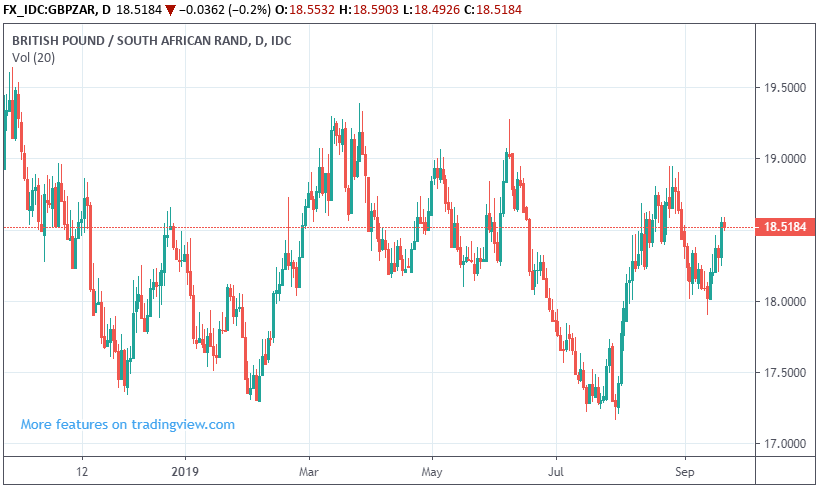The South African Rand is Tipped to Suffer after being Left Out in Cold by the Fed
- Written by: James Skinner

Image © Adobe Images
- The ZAR offers the best risk-reward to sellers says UBS analyst.
- To be tested by Fed reluctance to indulge market rate demands.
- Fed hint of no more cuts puts ZAR at mercy of investor sentiment.
- But CIBC tips ZAR for steady gains, says the USD is set to soften.
The Rand ceded ground to its major counterparts in a risk-off market Friday and is at risk of further losses in the months ahead, according to analysts at global banking giant UBS, who say the South African currency offers among the most attractive risk-reward ratios out there to short-sellers.
South Africa's Rand has now fallen close to 1.5% against the Dollar and almost 2% against Pound Sterling in the last week, with losses escalating since Wednesday when the Federal Reserve (Fed) hinted strongly that policymakers do not currently intend to cut U.S. interest rates any further this year.
American policymakers have cut the Fed Funds rate twice in 2019 but said Wednesday their domestic economy remains in fine fettle, albeit that risks to the outlook have increased since the July meeting, due mainly to another ongoing escalation of the U.S.-China trade war. The likely implications of this view for the Fed Funds rate were borne out in the September 'dot plot' of median projections for rates over the coming years.
"The Fed Chair continued to sound fairly optimistic about the economic outlook during the press-conference and the Fed dots did not show further cuts this year or next," says Vassili Serebriakov, a strategist at UBS. "This is consistent with our view that with four cuts (1-year out) in the price ahead of the meeting, it will be difficult for the Fed to out-dove the market pricing Fed neglects to indulge SARB holds amid rising oil prices."
The Rand had weakened steadily in the runup to the meeting and throughout September as investors appeared to doubt earlier bets the Fed was readying itself for a signfiicant cycle of interest rate cuts that were expected to weaken the were expected to weaken the Dollar and provide relief to emerging markets that have suffered from a strong U.S. currency in the last 18 months or so.

Above: USD/ZAR rate shown at daily intervals.
High American interest rates can raise the cost of financing for emerging economies when they borrow from the market because the U.S. benchmark is effectively the global 'risk free' rate that plays an important role in dictating the returns demanded by investors in all financial assets, but especially bond market investors who loan money to governments. High or rising rates in America also boost demand for the Dollar and lead to a stronger U.S. currency that is itself problematic for the emerging world.
A strong and rising greenback lifts the cost of repayments for the Dollar-denominated debts of countries using other currencies. And because of the volatile as well as risky nature of emerging markets, investors often seek to lend to those economies in Dollars rather than in their domestic currencies. This makes the Fed's decision all the worse for South Africa, because it's now seen leading the Dollar to trade stronger for longer than was previously thought.
"[Wedesday's] outcome is likely to be a test for the more vulnerable pro-risk currencies which have relied on DM central bank dovishness for support at the time when global growth remains weak. We think the risk-reward is the most attractive for shorts in the credit-sensitive EM currencies such as TRY and ZAR,"Serebriakov says. "Gold dipped below $1500 after the Fed as it continues to consolidate after the early -September pullback but we expect investors to start rebuilding longs as global uncertainties persist."
Investors had been anticipating close to five 25 basis point rate cuts from the Fed between September and the beginning of 2021 going into Wednesday's meeting and were still looking for 75 basis points worth of cuts over that period on Friday, with some of the difference being accounted for by the 25 basis point reduction to the Fed Funds rate that took it down to 2% this week.

Above: Pound-to-Rand rate shown at daily intervals.
Analysts say, for the time being at least, the market will continue to bet those remaining cuts are delivered eventually. However, and as time passes, investors will be forced to abandon those bets if there's no change of tune from the Fed in the interim which could offer support to the Dollar and put pressure on the Rand up ahead. However, not all are on board with this scenario.
"Q2 GDP in South Africa surprised to the upside at 3.1% vs. 2.5% expected. This has led to a sharp move lower in USD/ZAR from ytd highs of 15.4995. A positive risk environment and a softening USD will continue to support the ZAR tactically. In addition, higher gold prices have improved terms of trade for the economy, supportive of an extension lower," says Bipan Rai, head of FX strategy at CIBC Capital Markets. "Looking at longer term fundamentals, the South African economy is still in need of reform."
CIBC is looking for the Dollar to soften as 'safe-haven' flows abate following an eventual resolution of the U.S.-China trade war, an amicable Brexit from the EU for the UK and a pickup in economic growth outside of the U.S.
Rai and the CIBC team say this should help lift the Rand against the greenback into year-end and throughout 2020, although the outlook for the Pound-to-Rand rate is a bit more complex.
CIBC forecasts the USD/ZAR rate will fall to 14.50 by year-end and decline steadily to 13.70 by the time the curtain closes on 2020. The Pound-to-Rand rate is seen falling from 18.50 Friday to 17.41 by year-end but an anticipated resolution of the Brexit saga is expected to lift Sterling next year, leading the Pound-to-Rand rate back up to 18.50 before the end of 2020.
Time to move your money? Get 3-5% more currency than your bank would offer by using the services of foreign exchange specialists at RationalFX. A specialist broker can deliver you an exchange rate closer to the real market rate, thereby saving you substantial quantities of currency. Find out more here.
* Advertisement




